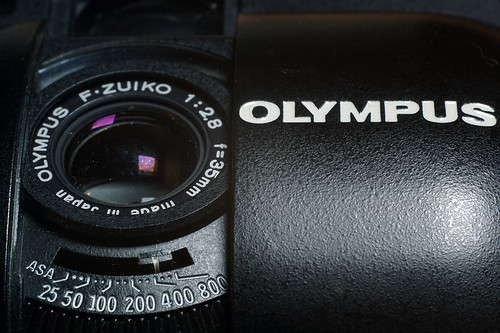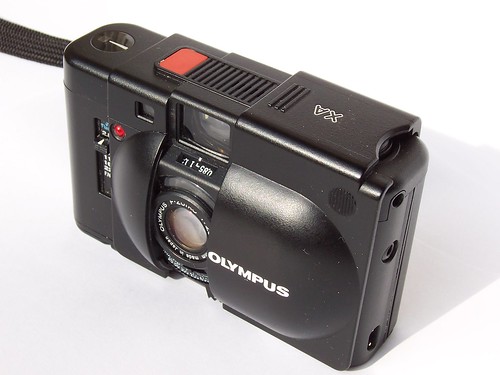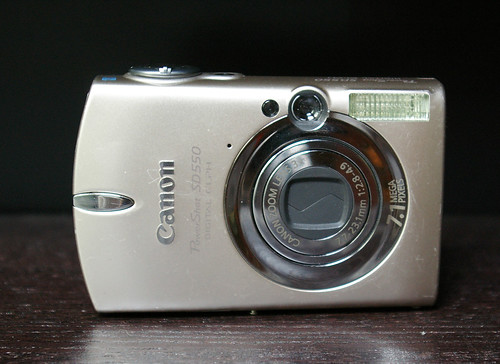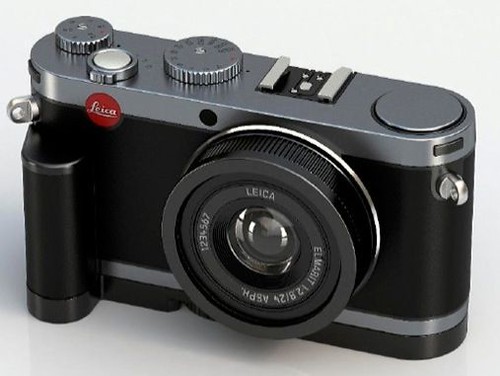
I have used many compact digital cameras, and I can say the handling, image quality, and versatility of any compact digital currently on the market is well below the standard set decades ago by cameras like the Olympus XA. The XA is silent, a quick shooter, with a high-quality 35mm f/2.8 6-element glass lens. Its integrated clamshell design allows for pocketed carrying, its rangefinder focusing is accurate and fast, and the hair-trigger shutter release allows for shake-free exposures. It has a minimum of controls that allow for quick but accurate exposures every single time.

By contrast, my wife's Canon digital Elph has a tiny, near-useless viewfinder, but even that is absent on many compacts. Instead you have to use the battery-draining LCD to compose, which is only partially useful in bright light situations. There is of course the well-known compact camera autofocus shutter lag, which can cause many users to miss "the moment." The lens has the bonus of having a small zoom range, but the quality of the lens, and the resulting photo quality, is inferior to the aged XA. Worst of all in my opinion is the way designers have added so many features as to make these cameras so user-unfriendly. 10+ "scene" modes, button- and menu-based controls that are not intuitive, white balance controls that neither produce pleasing results nor are simple to set, all of these factors contribute to make a camera that is the opposite of what a "Point and Shoot" camera ought to be.

The marketplace is wide open at the moment for a pocketable high-end camera with good picture quality and a simplified interface. Leica seems to have gone after this market with their new X1, but the cost is too high for average users to even think about, at $2000. Other cameras in the marketplace that are closer to the XA standard include Ricoh's GR-D series and Sigma's DP-1 and 2, all of which have their positives and negatives that dpreview does a good job covering.

As it is, I still wait for a camera that combines a good sensor, intuitive controls, and a superior fixed lens. Give me a camera that has manual aperture-priority mode only, a 35mm equivalent lens at f/2.8, an optical viewfinder and preferably a rangefinder, and make it small enough to fit in a pocket. Make it quiet, quick, and black.


5 comments:
I picked up a XA very recently off of ebay for exactly the reasons you've pointed out. I've yet to use it, it's so new. After reading your post I will go hunt down batteries for it immediately.
I am in the market for a new digital camera. My old camera is an olympus 3030, 10 years old and only 3.3 megapixel. I too have a bicycle blog and though the 3030 camera has served me well it is definitely time to improve the quality of the camera I use. I am considering a Canon G10. What do you think?
The G10 is certainly a nice camera for what it does. It;s got a good zoom range, an optical viewfinder, and it's about the right size. It does have all my concerns about too many menus and options of course, but nowhere in the modern camera world can you buy a nice camera with minimalist controls. In that class of digital camera, the panasonic LX3 and Canon G10 are probably far and away the best.
I would certainly try out the XA, as it's surprisingly good. Surprises me every time I get a roll developed. It's probably not the best camera to share photos online though, as film is a pain to scan and can take a while to be processed.
The Olympus EP1>Panasonic GF1>Olympus??>Panasonic?? progression in the micro 4/3rds realm is promising as they add viewfinders, etc. but still we are talking about the rough equivalent to a half-frame 35mm camera with the added desensitivities (if that can be a word) a small high-megapixal sensor creates. So not an XA in other words.
I doubt we will see a rangefinder in the affordable range, particularly a small one like the XA. They require too much skill to make and to keep in repair or alignment. EVFs are going to be the best we get on small P&S models, but I think with new OLED technology, EVFs could suddenly get much better.
In the end, there may be something about film (cost, size, etc.) that made it integral to the design of a small, high-quality camera. There may not be a way to make as good a camera at the same price without it. Film may have been the XA's optimum media.
Jorn, I'm seriously eyeing the GF1 as a replacement for my Canon Rebel. It's not everything I'd like, but I think it could make a decent camera with the use of older lenses, optical VFs, etc. A sort of digital Bessa-L, if you will. Look for a post on this coming up.
I want a DSLR.
Post a Comment